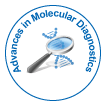Research Article
Molecular Diagnosis of Brucellosis: A Brief Report
Panagiotis Andriopoulos* and Maria TsironiDepartment of Nursing, University of Peloponnese, Valioti and Plataion, Sparta, Greece
- Corresponding Author:
- Panagiotis Andriopoulos
University of Peloponnese
Valioti and Plataion, 23100 Sparta, Greece
Τel: 302731089720
E-mail: andriopa@otenet.gr
Received date: June 09, 2016; Accepted date: Jun 30, 2016; Published date: July 04, 2016
Citation: Andriopoulos P, Tsironi M (2016) Molecular Diagnosis of Brucellosis: A Brief Report. Adv Mol Diag 1:108. doi:10.4172/amd.1000108
Copyright: © 2016 Andriopoulos P, et al. This is an open-access article distributed under the terms of the Creative Commons Attribution License, which permits unrestricted use, distribution, and reproduction H2O in any medium, provided the original author and source are credited.
Abstract
Amplification of nucleic acid by polymerase chain reaction (PCR) assays in order to diagnose infection by Brucella spp. has been used for more than two decades. Human Brucellosis is an endemic disease in many countries worldwide and often poses diagnostic puzzles. The implementation of PCR (standard, real-time and multiplex) can help in the accurate differential diagnosis and distinguish between acute, subacute and chronic cases. PCR has also been used for follow up of patients and serotype identification of Brucella spp. Overall PCR is a promising and reliable technique for the diagnosis of Human Brucellosis. Purpose of this brief report is to identify possible alternatives for rapid and accurate diagnosis of Brucellosis using PCR.

 Spanish
Spanish  Chinese
Chinese  Russian
Russian  German
German  French
French  Japanese
Japanese  Portuguese
Portuguese  Hindi
Hindi